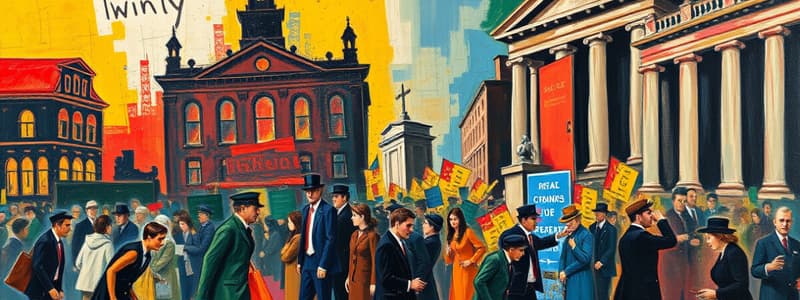Podcast
Questions and Answers
Which of the following are causes of the Great Depression? (Select all that apply)
Which of the following are causes of the Great Depression? (Select all that apply)
- New Deal
- Stock Market Crash (correct)
- Hawley Smoot Tariff (correct)
- Dust Bowl (correct)
What was buying on credit?
What was buying on credit?
A system where people made payments over time for items they could not afford upfront.
What event is commonly associated with the start of the Great Depression?
What event is commonly associated with the start of the Great Depression?
The Stock Market Crash on October 29, 1929.
What were the consequences of bank failures during the Great Depression?
What were the consequences of bank failures during the Great Depression?
What happened to the gap between the rich and poor during the Great Depression?
What happened to the gap between the rich and poor during the Great Depression?
The reduction in purchasing led to an increase in workforce.
The reduction in purchasing led to an increase in workforce.
What was the effect of the Hawley Smoot Tariff?
What was the effect of the Hawley Smoot Tariff?
What were some environmental causes of the Dust Bowl?
What were some environmental causes of the Dust Bowl?
Who was John Dillinger?
Who was John Dillinger?
What happened to Bonnie and Clyde?
What happened to Bonnie and Clyde?
Flashcards are hidden until you start studying
Study Notes
Causes of the Great Depression
- Major factors include stock market crash, Hawley Smoot Tariff, Dust Bowl, bank failures, buying on credit, reduction in purchasing, and the gap between the rich and poor.
Stock Market Crash
- Occurred on October 29, 1929.
- Often mistaken as the entirety of the Great Depression; it was a significant trigger.
- Estimated losses for stockholders exceeded $40 billion in two months.
- Some market recovery occurred by late 1930, but it was insufficient to avert economic decline.
Buying on Credit
- Installment buying became prevalent in the 1920s during economic prosperity.
- Consumers purchased items like cars and refrigerators on credit, leading to significant debt.
- When the market crashed, job losses prevented repayment of debts incurred through this system.
Bank Failures
- Over 9,000 banks failed throughout the 1930s.
- Bank deposits were uninsured, resulting in total loss of savings for many.
- Surviving banks were hesitant to issue new loans, exacerbating economic downturn.
Gap Between the Rich and Poor
- Wealth inequality increased significantly; the wealthiest 1% saw income rise by 75%.
- The remaining population only experienced a 9% increase in income.
- More than 70% of American families earned less than $2,500 annually.
Reduction in Purchasing
- The stock market crash prompted individuals to stop spending.
- Decreased production led to job losses; repossession of items bought on credit occurred.
- Unemployment reached 25%, leading to further reduction in consumer spending.
Hawley Smoot Tariff
- Enacted in 1930 to protect American businesses by imposing high tariffs on imports.
- Resulted in a decline in international trade and strained economic relations with foreign countries.
Dust Bowl
- Poor farming practices and overgrazing resulted in soil degradation.
- Major droughts between 1926 and 1934 worsened conditions, culminating in dust storms.
- Approximately 89 million acres of farmland were severely affected, forcing thousands to abandon their homes.
Depression Era Criminals
- Financial losses fostered public resentment toward banks, leading to admiration for gangsters.
- Criminal figures were seen as heroes in a struggling economy, despite their illegal activities.
John Dillinger
- A notorious gangster who became a symbol of the era, known for his violent escapades in the Midwest.
- Responsible for the deaths of 10 men, wounding 7, and orchestrating multiple bank robberies and jail breaks.
Bonnie & Clyde
- Infamous duo whose crime spree captured national attention, culminating in their deaths on May 23, 1934.
- Both were wanted for numerous violent crimes, highlighting the lawlessness of the time.
Studying That Suits You
Use AI to generate personalized quizzes and flashcards to suit your learning preferences.




